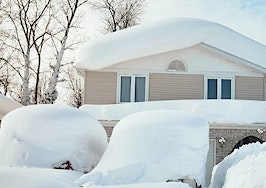- Housing stock in many of the most rapidly gentrifying neighborhoods in the country predates the 1970s and, in many cases, the 1950s.
- Older homes often have the sought-after features many buyers want.
- Greater housing density often lends to better walkability, greater access and more amenities.
For many people, buying a new home doesn’t mean buying a new home at all. Whether the property was built 10 or 110 years ago, existing housing stock is a popular choice for a lot of reasons — not the least of which is the fact that it’s right there, ready for your walkthrough.
Personally, I feel that investing in older homes (pre-1950s) offers a lot of opportunities you simply don’t get with homes that are 10, 15, 20 years old. Having lived in various cities and towns in New England, I am certainly biased on this account.
I developed an appreciation of historic homes early in my life. It began with the tiny downtown district of my hometown in Maine and continued when I moved to the bustling art and culture hub in Providence’s West Broadway/Armory district with its stunning assortment of Victorian multifamily homes and mansions.
Walking through these historic districts, you begin to understand how revitalizing old stock neighborhoods is crucial for preserving the personality and culture of a city.
There are economic benefits for cities that opt to put resources into revitalizing these districts, too. Revitalization inspires local business growth, reduces crime and blight and makes people want to live in these neighborhoods.
Older housing stock across the country is not only historically and culturally important, but it also makes for a great real estate investment.
The housing stock in many of the most rapidly gentrifying neighborhoods in the country predates the 1970s and, in many cases, the 1950s (Echo Park in Los Angeles, San Francisco’s Mission District, Denver’s Capitol Hill, Fishtown in Philidelphia, Northeast Portland — the list goes on).
For investors, some of the benefits to choosing older property include:
1. Targeting cheaper areas
In many major cities, older housing stock can be found in neighborhoods that are less expensive than others.
[Tweet “Older housing stock can often be found in neighborhoods that are less expensive than others.”]
Up until fairly recently, the bulk of new development happened on the outskirts of most cities in suburban and exurban areas, while the historic core of many cities were left untapped — and in many cases, left to decay.
With recent youthful pushback into America’s urban downtowns, these neighborhoods are back in demand, though the process of development is often patchwork — going street by street and block by block.
Buying into revitalizing cores and purchasing older housing stock where it’s still cheap gives you the chance to buy a less expensive dated home in a neighborhood with the opportunity to blossom.

Lev Kropotov / Shutterstock.com
2. The chance to upgrade
Whether you’re looking for a quick turnaround or long-term rental revenue, renovating an older house gives you more leeway for improvements of varying degrees and effort.
Houses that have fallen into absolute disrepair can be prohibitively expensive to fix for people who don’t specialize in full rehabs. But places in good condition that remain behind-the-times in fashion, appliances and layout can be turned around and made appealing to buyers with a small investment.
Considering the number of homes you can get in the $60,000 to $80,000 range in many cities across the country, the potential for a strong turnaround is high for conscientious flippers.
However, it’s important not to make the type of updates that destroy the character of the home. Scrapping historic features such as original molding or claw foot tubs, choosing an ultra-trendy motif or installing cheap fixtures eliminates the charm of an older property and pushes away aspiring buyers.
3. Historic touches
Trends change, but older homes feature many of the historic touches that people continually desire in a home — and often try to mimic in new construction.
Walking through a neighborhood of vibrantly painted Victorian homes creates an entirely different effect than a suburban neighborhood of new development that might command more-per-dollar.
People not only enjoy the experience of being surrounded by history, but there is also a concrete and quantifiable value to emphasizing the history of a neighborhood.
Homes in designated historic districts also command higher appreciation over time — upward of 5 percent to 35 percent more over the course of 10 years according to Governing.org, which incentivizes buying and holding these properties as rentals.
[Tweet “Homes in designated historic districts also command higher appreciation over time.”]
4. Housing density
Older homes were generally built closer to the city center. Depending on what part of the country you live in, they likely were built in a period before cars took over as the predominant mode of transportation.
This means higher density, better walkability and easier access to local amenities, which can mean higher demand, especially among young homebuyers who want access to work and play via bicycle, public transit or foot.
In parts of the country where single-family homes are the dominant older housing stock, the homes are generally more compact. With closer access to amenities than those properties in the suburbs, they’re also set along roads that connect residential spaces with downtown commercial areas.
5. Converting possibilities
Before the popularity of single-family homes took hold in the suburbs of major Eastern cities, people of moderate means predominantly lived in multifamily apartment dwellings close to the urban center.
Other families of more substantial wealth would build similarly styled, three-story homes on smaller lots. If you are looking to turn a sale rather than manage rental properties, both of these types of homes can be converted into multifamily condos.
[Tweet “Buying existing stock means not having to wait around for your investment to be built.”]
Handy investors who do much of the work themselves can take advantage of this by doing renovation tasks on their own timetable, without delay — and without having to coordinate framers with roofers and plumbers with electricians.
Homes are right there, waiting for you. Timing is everything when it comes to investment. Buying existing stock means not having to wait around for your investment to be built from the ground up.
Nicholas Brown is a Los Angeles-based writer for JustRentToOwn.com. You can follow his Twitter at @justrenttoown or check in at his blog.








